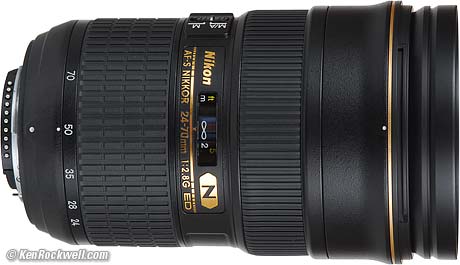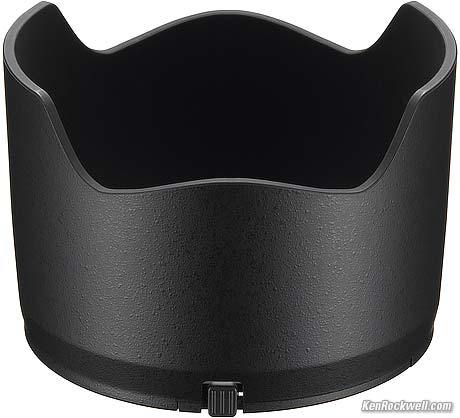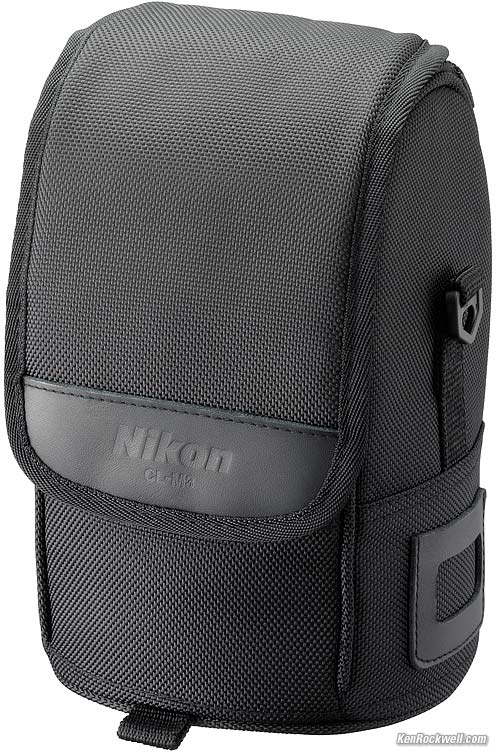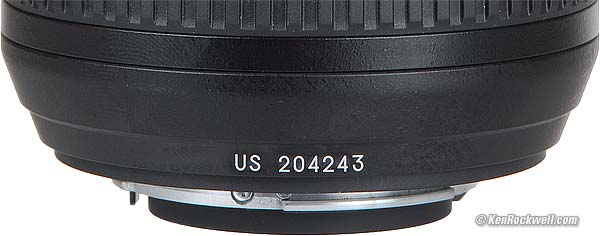 Nikon AF-S 24-70mm f/2.8 G ED. enlarge.
Nikon AF-S 24-70mm f/2.8 G ED. enlarge. I've already gotten mine from Ritz. You also can order it from Adorama or Amazon. (I'd use Adorama; Amazon still seems clueless about dates). It helps me keep adding to this site when you get yours from those links.
November 2007
More Nikon Reviews
New: 23 November, 2007: Full-Resolution, Full-Moonlight Example Photo from D300, at 70mm and f/2.8! To those of you who know lenses, this wide-open tele shot should say it all. Focus is on the nearer row of houses, not infinity. Most other zooms look like mush at this setting and need to be stopped down to become this sharp.
INTRODUCTION
Top Specs Performance Recommendations
What makes the Nikon 24-70mm so special is how it feels. Optically it's as excellent as we expect, but so were the 35-70mm f/2.8 AF and 28-70mm f/2.8 AF-s.
What makes the 24-70mm stand out from its predecessors its lack of klunk factor. The 24-70 doesn't get in your way. The 24-70 is an exquisite hunk of solid metal that just makes pictures with no fiddling. It feels as if it was hewn from a single solid ingot.
The original 35-70mm f/2.8 AF works great, but you have to jack it around by moving mechanical switches to get into macro or manual focus modes. If you shoot all day with it, screw that.
The previous 28-70mm f/2.8 AF-s eliminates the switches, but was such a big fat lens that I was always scared of it. The first generation AFS motors were very big, so the rear and zoom ring of the 28-70 had to be very large. I think I needed two fingers to focus or zoom it.
By comparison, this newest 24-70 is a solid block of smooth, easy precision. It just works, and doesn't grate on you all day shooting with it. The 24-70mm is all metal with an engraved zoom ring. Manual focus flicks with a light touch from one finger, a Nikon hallmark since the 1950s. AF lenses rarely feel this good for manual focus. I can shoot and zoom the 24-70 with one strong hand.
This 24-70mm focuses closer (1.2' versus 1.5' or 0.38 vs 0.5m), zooms wider (24 vs 28mm), and is 0.4" (11mm) longer and 1.2 oz. (35g) lighter than the 28-70mm f/2.8 AF-s it replaces. More importantly, it's 0.2" (6mm) smaller in maximum diameter, making the zoom ring movable with one finger, not a two-finger death grip.
The 35-70mm f/2.8 AF is much smaller and lighter than either AFS lens. If you don't mind some klunkiness and the narrower zoom range, you can get about the same optical performance in a smaller package in the 35-70mm f/2.8 AF for about $470 brand-spanking new. The 35-70mm isn't made any more, so don't dawdle if you want a new 35-70mm.
Nikon announced this 24-70mm f/2.8 zoom on August 23rd, 2007, along with its sister 14-24mm f/2.8 lens and the full-frame Nikon D3 body.

Nikon 24-70mm f/2.8G AF-S.
Compatibility
This 24-70mm works perfectly on every DX and FX digital SLR, including the D40. If all you shoot is digital, feel free to skip ahead.
As a big, heavy, expensive full-frame lens, it's silly to use this 24-70mm f/2.8 on the smaller DX cameras, and sort of defeats the purpose of the lightweight and inexpensive D40, although it works flawlessly on any of these cameras. For DX cameras, I'd get something else, since 24-70mm is a silly zoom range on DX. You are paying a big premium for FX coverage if you don't intend to use it on an FX camera.
The ideal use of this big 24-70mm is on a big camera, which means the D3 or film.
It works great on the F4, F5 and F6. Even on the 1988 F4 you get super fast autofocus, Matrix metering and P and S automatic exposure modes. (forget Manual and aperture-preferred on the F4.)
This 24-70mm AF-s is the first f/2.8 mid-range zoom to be useless with manual focus cameras.
This lens is a G (gelded) version, meaning Nikon crippled it for use on manual focus cameras by removing its aperture ring to save cost. For the pro film cameras, this means forget it with the F, F2, FM, FE, FA, F3HP and FM3a, unless you want to use stop-down metering at f/22 only.
The 28-70mm AF-s has an aperture ring for use on manual focus and very old AF cameras.
This 24-70mm AF-s won't autofocus on some of the very earliest or cheapest AF film cameras like the N55.
See Nikon Lens Compatibility for more. This is an AF-S and a G lens.

Private parts of the Nikon 24-70mm f/2.8.
Nikon 24-70mm f/2.8 AF-S nameplate.
Name: Nikon calls this the AF-S Nikkor 24-70mm f/2.8G ED.
AFS: Quiet focusing SWM (silent wave motor) with instant manual focus override.
G: No aperture ring. Useless on manual focus cameras. Only works on AF cameras newer than about 1992, depending on camera. Works great on the 1988 Nikon F4 in P and S modes.
ED: Magic glass for sharper images.
It also has IF: Internal Focusing. The big gold N stands for Nano Crystal Coat, a new anti-reflection coating used on only one internal surface.

Nikon 24-70mm f/2.8 AF-S bottom markings.
The 10 inside recycling circles means that Nikon expects that this lens will be thrown into the dump in 10 years. I hope not, but that's what the "10" means.
All this and more explained in greater depth on my Nikon Lens Technology page.
Focal Length: 24-70mm. This lens is intended for use on film and full frame cameras, on which it is obviously a 24-70mm equivalent.
Used on a DX digital SLR, it gives angles of view similar to what a 37-107mm lens would give on a 35mm film or FX camera. Calculated in reverse, you would need a 16-46mm lens on a DX camera to replicate the angles of view that this 24-70mm lens gives on FX and film cameras. See also Crop Factor.
Diagonal Angle of View: 84° - 34.3° on film and FX format; 61° - 22.8° on DX cameras.
Maximum Aperture: f/2.8. Optics: 15 elements in 11 groups. Three of these are ED glass, which helps reduce color fringing. Three are glass-molded aspherical. One surface of one element (only) has Nikon's special Nano Crystal anti-reflection coating. That's the big N logo on the lens.
Diaphragm: wonderful 9 blade rounded, stopping down to f/22.
Filter Size: 77mm.
Close focus: 1.2' (0.38m) from the image plane (the back of the camera), marked.
Maximum Reproduction Ratio: 1:3.7, which is pretty close! The 28-70mm f/2.8 AF-s only gets to 1:5.6.
Infrared Focus Index? NO.
Mechanics: All metal. Engraved markings on zoom ring. Dust and moisture resistant.

The huge Nikon D3 dwarfed by the even bigger 24-70mm. Size: 3.3" diameter x 5.2" extension from lens mount (83 x 133mm). The 28-70mm f/2.8 AF-s is 3.5" x 4.8" (88.5 x 121.5mm).
The front extends at the ends of the zoom range. The Nikon 24-70mm is shortest when set to 50mm as pictured. The front group extends an additional 4mm at the 70mm focal length or an additional 20mm at the 24mm focal length. Focus is internal.
Weight: 31.820 oz. (1.9888 pounds or 902.05g), measured by me, naked. Nikon specifies 31.7 oz. (900g). The 28-70mm f/2.8 AF-s weighs 33.0 oz. (935g). (Nikon USA mistakenly calculated the weight from grams as 2.45 pounds, which you'll see repeated many places in the USA, whoops!)  Nikon HB-40 hood.
Nikon HB-40 hood. Hood: HB-40 plastic bayonet, included.
 Nikon CL-M3 semi-soft case.
Nikon CL-M3 semi-soft case. Case: Semi-soft Case CL-M3 and strap included (same case as 14-24mm). Belt loop, velcro and dual-zipper closure. The lens ships inside the case with hokey white foam on the top and bottom, I'm presuming that's just to snug it up for shipping.
Announced: 23 August 2007.
Available: Photographers started getting theirs 12 November 2007.
Price: $1,699.95 (USA).  Nikon 24-70mm box. That's gold foil - wow!
Nikon 24-70mm box. That's gold foil - wow! PERFORMANCE
TopIntroduction Specs Recommendations
 I just got my lens, so each time you hit REFRESH you'll see me typing away. Give me a few days (it's Friday, November 16th today) to complete everything.
I just got my lens, so each time you hit REFRESH you'll see me typing away. Give me a few days (it's Friday, November 16th today) to complete everything. Utility
The Nikon 24-70mm is very easy to use. It's the easiest-to-use professional midrange zoom ever offered by Nikon.
This is important if you're shooting all day. Little annoyances turn into big pains fast.
Manual Focus
Just spin the manual focus ring, no need for a clumsy switch.
It feels exquisite. It just turns, with no play, no backlash, no creep, very little effort and no drag. You must feel it to believe it.
It's geared just about right at the wide end, which means it turns a little too fast for precise manual focus at the long end.
 Nikon 24-70mm M/A - M Switch.
Nikon 24-70mm M/A - M Switch.The M/A - M switch isn't needed for manual focus. It more properly should be marked "Deactivate AF"
The M/A position is the normal position. This means AF works, and all you need to do for manual focus is to move the ring.
The M position deactivates AF. In M the 24-70mm holds your manual focus position. even if you take your hand off the ring and tap the shutter button.
I'd prefer AF-Lock buttons on the lens. Some cameras can be programmed for this function.
Zooming

Nikon 24-70mm Zoom Ring.
The zoom ring is very well spread out, which makes precise composition a breeze.
See all the space between 35mm and 24mm? That's the way it's supposed to be.
Too many other lenses cram the wide angles too close together. It is bad when other lenses cram 35mm and 24mm almost on top of each other.
The Nikon 24-70mm's zoom ring is spaced at a constant 3 cm/octave. The same rotation always gives the same percentage change in image size, everywhere in the zoom range.
Bravo!
Filters
The front never rotates, although it does move in and out with zooming.
I don't need any special thin filters, but it's close at 24mm on film or an FX camera.
At 24mm on FX or film, my 7.2mm (0.28") thick traditional Hoya circular polarizer just barely avoids vignetting. It just barely becomes visible at the very closest focus distance.
I do get vignetting if I stack my 77mm circular grad over the polarizer at 24mm. The problem goes away at 28mm.
Any vignetting is more obvious at small apertures (f/16) than at large ones (f/4).
There is never a problem with DX cameras. (See Crop Factor.)
Construction
The metal barrel and everything appears finished in the same delicately mottled black paint as the 17-35mm AFS. I'm told it's epoxy paint which is a mix of epoxy resin and an accelerator. These are spat on the lens and cure to become hard and tough.
There's a rubber gasket on the mount to help seal out crud.
Filter Threads and Hood Bayonet: Seems like anodized aluminum.
Focus Ring: Rubber-covered metal.
Barrel: Metal.
Aperture Ring: None.
Markings: Mostly engraved or raised and planed; bottom markings are paint.
Switches: One plastic focus mode switch.
Mount: Metal, likely brass.
Internals: I see metal.
Noises when shaken: Lots of mild klunking, which is normal.  Nikon 24-70mm Serial Number, typical from first production run.
Nikon 24-70mm Serial Number, typical from first production run. Serial Number: Laser engraved in bottom rear of metal barrel. This makes for highly legible silver on black. Legitimate USA products are prefixed by "US."
Made in: Japan.
Optics
Overall, the 24-70mm is weakest at 24mm. It's at its best from 35-70mm, where it's easily the sharpest and highest performance lens I tested in this comparison.
Focus Accuracy
Focus seems AOK on my D40.
On my D200, autofocus focuses too closely at 24mm. At 24mm wide open, I get far better results using what we do in television studio production, which is to zoom into 70mm, lock focus, and zoom back out. On a D200 at defaults in AF-S mode, zoom to 70mm, press the shutter halfway, and hold it ot hold focus while you zoom back out to 24mm.
AF is fine from 35-70mm, even on my D200.
Sharpness
Duh, of course it's sharp. Why do otherwise reasonable people spend so much time worrying about such an insignificant issue, especially for a state-of-the-art Nikkor lens and especially when so few people ever print bigger than 13 x 19" (30 x 50 cm)?
Sharpness comes from a photographer's vision. It doesn't come the correct choice of lenses. All lenses are about as sharp at f/8, where we usually use them. The differences I'll reveal below are applicable only at large apertures. Lenses get sharper as stopped down, until about f/8, beyond which diffraction sets in.
Just for fun, I shot off the 24-70mm against everything but a 28-70mm AFS (I don't have one of those handy, but will). When my D3 arrives, I'll do that, too.
When I say 28-70mm AF-D, I mean the 1990's compact zoom, not the f/2.8 AFS. I can add more lenses as I stop down, since fewer lenses open up to f/2.8.
Lenses Compared (only some at each focal length):
17-35mm AF-S
18-35mm AF-D
18-55mm AF-S II
Ugly 24mm f/2.8 pre-AI
24mm f/2.8 AF-D
24-120mm f/3.5-5.6 AF-D "Streetsweeper"
24-120mm f/3.5-5.6 VR
28mm f/2.0 AI-s
28mm f/2.8 AI-s
28-70mm f/3.5-4.5 AF-D (not the f/2.8 AF-s)
28-80mm f/3.3-5.6 G (nasty silver-painted version)
35-70mm f/2.8 AF-D
35mm f/2.8 Nikkor-S (AI-converted)
50mm f/1.8 AF-D (China)
50mm f/1.4 AF-D (China)
Of course there always are shot-to shot variations, but here's a rough idea of what I saw on my D200. The sharpness differences I see are at a 44" (1.1m) print size seen from a foot or two away on my monitor. These differences would be hard to see in 13 x 19" (30 x 50cm) prints, and you'd need to get out a magnifier to see anything in 8 x 12" (25 x 30cm) prints.
At 24mm
At 24mm and f/2.8, I discovered that the focus is consistently in front of the subject on my D200, so it's not sharp enough for testing at 24mm. (It's perfect on my
D300 and D40; I just didn't use them at first.)
24mm is the 24-70mm lens' weakest setting. Every other lens was sharper due to the focus issue.
When I figured out a work-around, which is to AF at 70mm and zoom back out (which is cheating), here's what I see:
f/2.8: The 24-70mm is the clear winner. The 17-35mm is second, the 24mm f/2.8 AF-D third, and the ancient, ugly 24mm AI-conversion last.
f/4: The newest 24-70mm AFS wins again. Second place is tied among the 24-120mm AF-D "Streetsweeper," 18-35mm AF-D, 17-35mm AF-S, 24mm f/2.8 AF-D and 24-120mm VR. THe hocky-puck 24mm AI Conversion is worst, but not mby much. The 24-70mm stands alone.
f/5.6 - f/8: At f/5.6 to f/8 the lenses are more or less as sharp as one another. The issue at moderate apertures is lateral color fringing. The 24-120mm VR, 17-35mm AFS, 18-35mm AF-D have none. The 24-120mm AF-D has some. THe 24-70mm AF-S, 24mm AF-D and the beater 24mm AI conversion have visible lateral color, at least at the crazy magnifications I'm using. THe 24-70mm tends to be a little sharper than some other lenses, but has a little more lateral color, so it's a toss up among them.
At 28mm
At 28mm the 24-70mm is OK, but not a clear winner from some residual AF error on my D200. Here's what I see, shooting them fairly against one another:
f/2.8: The 28mm f/2.8 AI-s is sharpest all over. The 24-70mm is the same as the 28mm f/2.0 AI-s, when all are shot at f/2.8.
f/4: The 24-70mm is as sharp as the 28mm f/2.0 AI-s. The 28mm f/2.8 AI-s is better, and lo and behold, the best is the small 28-70mm f/3.5-4.5 AF-D I bought used from Adorama for $100.
f/5.6: At f/5.6 and smaller they are all equally sharp. They all also have the same amount of lateral color fringing, except for the small 28-70mm f/3.5-4.5 AF-D which has none.
If I cheat and focus the 24-70 AFS at 70mm and zoom back out, which imprioves it slightly, and also throw three more lenses into the mix that weren't included above:
f/2.8: Now the 24-70 beats all. The 28mm f/2.8 AI-s and 28mm f/1.4 AF-D are close seconds. The 17-35mm AF-S and 28mm f/2.0 AI-s are worse.
f/4: THe 24-70mm wins again. THe 28-70mm AF-D is second. THe 28mm f/2.8 AI-s, 28mm f/2.0 AI-s, 18-35mm AF-D and 28mm f/1.4 AF-D are tied for third. The 17-35mm AFS and 28-80mm G are last.
f/5.6: THere isn't much difference at f/5.6. THe 24-70mm wins. The 28-70mm AF-d and 28mm f/1.4 A-D is second. THe two AI-s 28mm lenses, the 18-55mm AF-s kit lens, and the 18-35mm are all third, but not by far. The 17-35mm AF-S is last. None of these lenses have any significant lateral color fringing.
At 35mm
At 35mm, the 24-70mm has finally hooked up and is easily the best of the lenses I tested at 35mm.
f/2.8: The 24-70mm is clearly the best, sharp and devoid of lateral color even wide open. The 17-35mm AF-S is a close second. The 35-70mm f/2.8 AF is third and has some lateral color. The 1972 35mm Nikkor-S (AI converted) was clearly the worst.
f/4: The 24-70mm is clearly much better than the 28-80mm G, 18-35mm AF-D, 28-70mm AF-D and the 35mm Nikkor-S. The 17-35mm AF-S and 35-70mm f/2.8 AF-D are a close seconds.
f/5.6 - f/8: The sharpness differences lessen, although the 24-70mm still wins. The 35-70mm f/2.8 AF-D, 18-55mm AF-S kit lens, 17-35mm AF-S, 18-35mm AF-D and 28-70mm AF-D and 35mm Nikkor-S are similar. The 28-80G is the loser.
As the softer lenses have sharpened up, lateral color is obvious in the 35-70mm f/2.8 AF-D and somewhat in the 35mm Nikkor-S, 18-35mm and 17-35mm. . There is no lateral color in the 24-70mm, 28-80mm G, 28-70 AF-D or 18-55mm AF-S.
At 50mm
Golly, at 50mm the 24-70mm also is the clear winner, even better than the fixed 50mm f/1.4 AF-D and 50mm f/1.8 AF-D!
f/2.8: The 24-70mm is clearly the sharpest. The 50mm f/1.8 AF-D is a far second, and the 35-70mm f/2.8 AF-D and 50mm f/1.4 AF-D are the worst.
f/4: The 24-70mm wins again. The 28-70mm AF-D is tied with the 50mm f/1.8 and 28-80mm G for second. The 35-70mm f/2.8 AF-D loses.
f/5.6: Similar to before with the differences less obvious. The 50mm f/1.8 and 28-70mm AF-D are close seconds. All the others, as well as the 24-120mm VR, are all tied for last.
At 70mm
The 24-70mm wins again, although I only compared it to mid range zooms, no pro tele zooms and no fixed lenses.
f/2.8: The 24-70mm is sharper, contrastier and has much less lateral color fringes than the 35-70mm f/2.8.
f/4: The 24-70mm wins, with the 35-780m a closer second. The 28-70mm AF-D is a far last.
f/5.6: 24-70mm wins. 35-70mm is second. 28-70mm AF-D and 24-120mm VR tied for third. The cheap est 28-80mm G loses.
Lateral Color Fringing
Lateral color fringing is minimal at 24mm.
It's gone from 28mm through 70mm.
This is as I measured on a D3; it will be less on a DX camera (see Crop Factor).
Nano Crystal Coating
Nano Crystal Coating is a new kind of coating to reduce flare and ghosts. There is only one internal surface with this coating.
This is the big gold "N" on the barrel. To you and I, coatings are just one tiny part of a far more complex issue. This is Nikon's new marketing letter to push lenses on the innocent. Nikon has invented a new letter about every 7 years. "N" is merely incremental, as AF-D is from AF or AI-s is from AI. Don't stay up at night worrying about it.
A lens' ghost, flare and contrast performance depend on many, many many factors. It depends more on the wisdom of the lens designer than a coating on one surface of one element. The other zillion surfaces have Nikon's traditionally excellent Super Integrated Multicoating (SIC).
Flare and Ghosts
You really have to be doing something stupid to see any ghosts. For all reasonable photo situations, including those with the sun in the image, the ghosts fall outside film or digital's dynamic range.
There can be a couple of spots if you deliberately try to create them. I wouldn't worry about this. It's better than the 35-70mm f/2.8 AF.
Distortion
Distortion is stronger than I had hoped at 24mm, otherwise, no surprises. Shoot it at about 30mm and the distortion goes away.
Luckily, for the one shot in a thousand where you might care, it's easy to correct completely in Photoshop CS2's lens distortion filter. There is no weird waviness as is common with other complex aspherical lenses. Distortion, if any is visible, is one simple constant-radius curve.
The Nikon 24-70mm has strong barrel distortion at 24mm, and pincushion elsewhere. Use these numbers in Photoshop CS2's lens distortion filter to rectify it.
FX and film
DX
24mm
+4.0
28mm
+2.0
35mm
-1.0
50mm
-2.0
70mm
-1.0
Falloff (corner darkening)
Falloff on film or an FX camera, like the D3, is slight at f/2.8. It's gone by f/4 or 5.6.
THis is one of the subtle things Nikon improves each generation. The 24-70mm zoom has much less falloff than any of Nikon's fixed 24mm lenses.
I doubt it will ever be a problem in actual shooting.
There is no falloff on DX digital cameras (see Crop Factor).
Rated MTF Nikon's published graphs rate the 24-70mm as about the same to a little better as the 28-70mm f/2.8 AF-s, better than my favorite 24-85mm AFS and the 24-120mm VR and much better than the 24-85mm f/2.8-4 that I've never liked.
Of course these MTFs are dreams, which mean they are calculated, not measured from real lenses. Nothing is said if the published graphs are monochromatic, polychromatic, or integrated over white light, so they mean very little for comparison to real samples of lenses. Don't lose sleep over any of this.
Vibration Reduction
The Nikon 24-70mm has NO vibration reduction. Whoops!
I'm addicted to VR, and am very sorry this lens doesn't have it.







































 回复时引用此篇文章
回复时引用此篇文章





























书签